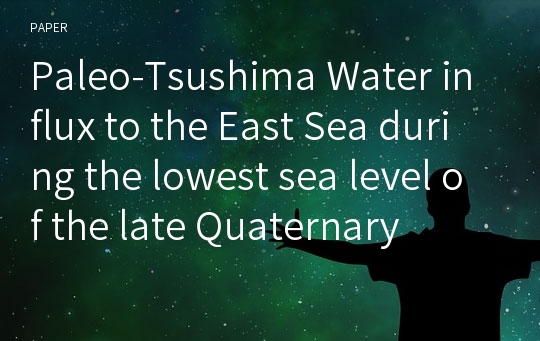Paleo-Tsushima Water influx to the East Sea during the lowest sea level of the late Quaternary
* 본 문서는 배포용으로 복사 및 편집이 불가합니다.
서지정보
ㆍ발행기관 : 한국지구과학회
ㆍ수록지정보 : 한국지구과학회지 / 26권 / 7호
ㆍ저자명 : Lee, Eun-Il
ㆍ저자명 : Lee, Eun-Il
영어 초록
The East Sea, a semi-enclosed marginal sea with shallow straits in the northwest Pacific, is marked by the nearly geographic isolation and the low sea surface salinity during the last glacial maximum (LGM). The East Sea might have the only connection to the open ocean through the Korea Strait with a sill depth of 130 m, allowing the paleo-Tsushima Water to enter the sea during the LGM. The low paleosalinity associated with abnormally light δ18O values of planktonic foraminifera is interpreted to have resulted from river discharge and precipitation. Nevertheless, two LGM features in the East Sea are disputable. This study attempts to estimate volume transport of the paleo-Tsushima Water via the Korea Strait and further examines its effect on the low sea surface salinity (SSS) during the lowest sea level of the LGM. The East Sea was not completely isolated, but partially linked to the northern East China Sea through the Korea Strait during the LGM. The volume transport of the paleo-Tsushima Water during the LGM is calculated approximately(0.5~2.1)×1012m3/yr on the basis of the selected seismic reflection profiles along with bathymetry and current data. The annual influx of the paleo-Tsushima Water is low, compared to the 100 m-thick surface water volume (about 79.75×1012m3) in the East Sea. The paleo-Tsushima Water influx might have changed the surface water properties within a geologically short time, potentially decreasing sea surface salinity. However, the effect of volume transport on the low sea surface salinity essentially depends on freshwater amounts within the paleo-Tsushima Water and excessive evaporation during the glacial lowstands of sea level. Even though the paleo-Tsushima Water is assumed to have been entirely freshwater at that time period, it would annually reduce only about 1‰ of salinity in the surface water of the East Sea. Thus, the paleo-Tsushima Water influx itself might not be large enough to significantly reduce the paleosalinity of about 100 m-thick surface layer during the LGM. This further suggests contribution of additional river discharges from nearby fluvial systems (e.g. the Amur River) to freshen the surface water.참고 자료
없음"한국지구과학회지"의 다른 논문
 종관적 특징에 따른 남한 강수 특성 분석: 30년 (1973~2002) 기후 통계12페이지
종관적 특징에 따른 남한 강수 특성 분석: 30년 (1973~2002) 기후 통계12페이지 행성상성운의 분포와 시선속도 연구7페이지
행성상성운의 분포와 시선속도 연구7페이지 적도 태평양 아표층 자료의 시계열 분석 및 표층 수온 예측8페이지
적도 태평양 아표층 자료의 시계열 분석 및 표층 수온 예측8페이지 한반도 중규모 대류복합체의 발달특성에 관한 연구8페이지
한반도 중규모 대류복합체의 발달특성에 관한 연구8페이지 고정밀 중력 탐사를 위한 3차원 중력 지형 역산 기법7페이지
고정밀 중력 탐사를 위한 3차원 중력 지형 역산 기법7페이지 원격탐사 자료 기반 지형공간 특성분석을 위한 텍스처 영상 비교와 템플레이트 정합의 적용8페이지
원격탐사 자료 기반 지형공간 특성분석을 위한 텍스처 영상 비교와 템플레이트 정합의 적용8페이지 삼성광산 일대의 견운모광화작용에 대한 광물학적 및 성인적 연구9페이지
삼성광산 일대의 견운모광화작용에 대한 광물학적 및 성인적 연구9페이지 튜빙의 종류에 따른 환원황화합물들의 흡착손실 비교 연구6페이지
튜빙의 종류에 따른 환원황화합물들의 흡착손실 비교 연구6페이지 흑산도 지역 장도습지의 지질 및 토양환경: 예비조사7페이지
흑산도 지역 장도습지의 지질 및 토양환경: 예비조사7페이지 전국 주요 행정구역별 PM10 성분의 시·공간적 농도분포의 특성조사9페이지
전국 주요 행정구역별 PM10 성분의 시·공간적 농도분포의 특성조사9페이지


























